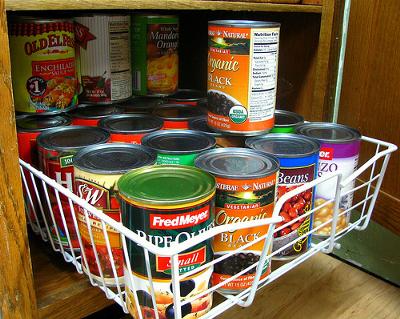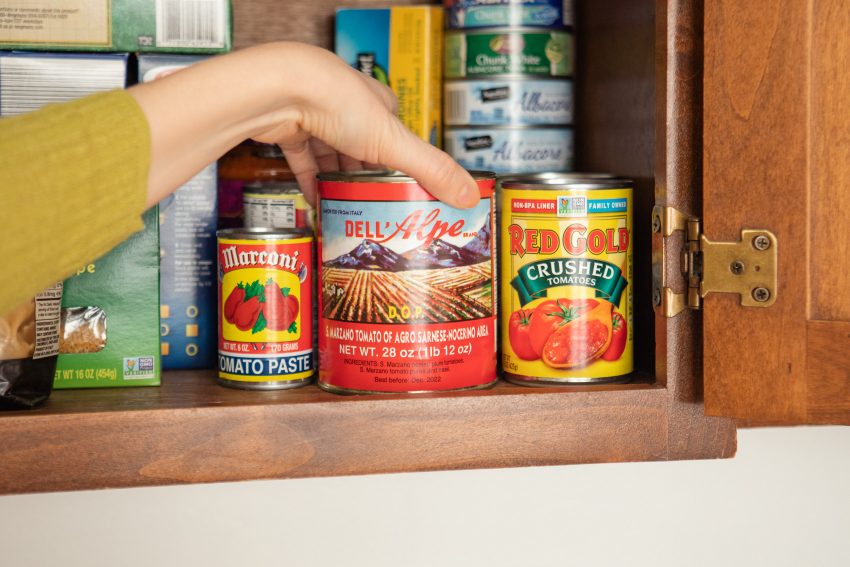Whether you’re preparing your favorite chili recipe or need a quick and easy corn side dish, serving canned food can make your kitchen life a whole lot easier.
Canned food makes up a large portion of the real pantry, but storage of canned food can be a problem.
Fortunately, there are plenty of ways to organize canned food in the pantry, cupboard, or drawer—you just need to get a little creative.
Table of Contents
Does Canned Food Expire?
Yes! There are several factors that can affect the shelf life of canned foods, such as can corrosion and rust, high temperatures, and other container issues. Many canned foods experience changes in taste and texture over the years and may eventually lose their nutritional value – which is why it is recommended to consume different types of canned products within a certain period of time for the best quality.
Tips To Store Canned Foods
- Stay out of the sun. Direct exposure to sunlight can actually affect the quality, color, and taste of food.
- The right space. Store canned food in a cool place, like a pantry or drawer.
- Check expiration dates. Canned food may expire. This can vary between 1-4 years, depending on the type of food, how the can is stored, and the condition of the can.
- Check for rust, leaks, or damage. Canned food is sealed to prevent bacterial growth. Throw away any jars that no longer appear to be sealed. They are not safe to eat.
- Store in a cool, clean, dry place below 85°F (50-70°F is ideal), but do not freeze.
- Rotate the food so that the oldest eats first. Try not to keep canned food for more than 1 year.
- Use canned meat and seafood within 3 years of the packaging date.
- Use low-acid canned foods, such as vegetables and soups, within 3 years of the package date.
- Consume high-acid foods such as fruit, pickles, and tomatoes within 2 years of the date on the package.
- Canned juice can be stored for up to 1 year.
- Foods that have been stored for longer periods of time will be safe if the cans show no signs of spoilage or damage, but the color, flavor, and nutritional value of the food may deteriorate.
How to Store Canned Food

The storage of canned food starts with a detailed process to ensure quality and safety. The goal is to maximize your storage capacity, make food more durable, and identify spoiled food when necessary.
- Step 1: Select the specified storage space
This area can be anywhere that suits you. The ideal location is the pantry in your kitchen, but if you don’t have room in your kitchen, it can be anywhere with a convenient access point. Other storage options include hallway closets, cupboards, bookshelves, and wide drawers.
Put it in an easily accessible place with enough space to store all your food. Before you know it, you’ll have the perfect pantry for canned food.
- Step 2: Clean Your Storage
Now that you have decided where your food will be stored, we must prepare the location correctly. Thoroughly clean all surfaces and surrounding areas. The goal is to maintain clutter-free storage space.
We also recommend vacuuming the surrounding area, washing the floors, and wiping down everything with the necessary cleaners. This also helps eliminate any risk of rodents or pests entering the storage area.
- Step 3: Create a Shopping List
Creating a shopping list requires you to create a budget and be disciplined about sticking to it. We often see homeowners go over budget when shopping, which does more harm than good. You can add more items at any time.
As you build your shopping list, try to create balanced meals with your food choices. Categories to consider include fruit, vegetables, canned meat, seafood, and juices.
- Step 4: Stock Up Your Pantry and Stack the Shelves
Now is the time to start organizing and storing food. Canned food can be quite heavy, so it’s worth checking the shelves you’re using. Make sure they can handle the required weight, as collapse or damage would be devastating.
Stack cans properly. We always recommend labeling cans with the expiration date as a safety measure to track food.
When you buy new cans, do the same and stack them back. This way, you can constantly rotate food in your pantry, keeping everything fresh and avoiding spoilage.
Where to Store Canned Food
There are several places to store canned food. This will ultimately depend on whether the canister has been opened and what the purpose of the storage is. The pantry remains the most popular and efficient option for canned food storage.
- Pantry
Your pantry or similar storage space is the best place to keep canned foods, especially unopened ones. When storing, look inside the can for dents or damage. This can create small holes in the can, allowing the food to spoil faster.
Your pantry should be a cool, dry place that doesn’t receive any direct sunlight. It should also be a place where the temperature remains stable. If the weather is too cold or too hot, your food will spoil faster.
Once a can has been opened, it is no longer eligible for pantry storage. Read on to learn what to do with opened cans.
- Refrigerator
There is no need to store any unopened cans in the refrigerator. However, any leftover contents from an open can be placed in the refrigerator for longer storage.
Avoid canning as a refrigerator storage method. It is best to pour the can into a refrigerator-safe container. This helps reduce the risk of botulism and makes the food more durable.
- Freezer
We recommend always avoiding storing any canned food in the refrigerator. Unopened cans can freeze in your refrigerator and have the potential to burst or explode, ruining the entire can.
How to Tell When Canned Food Has Gone Bad
Look – A very reliable way to tell if a canned food has gone bad is to look at the can. If the can is bulging, the contents are most likely spoiled. Bloat is caused by gases produced when food rots and mold grows.
If liquid spits or bubbles from the opening when opened, it is likely spoiled.
Finally, if there is any visible mold on the food inside the can, throw it away.
Odor – Canned food can also have an unpleasant odor when it goes bad, which can be emitted once the can is opened.
Tasting – We do not recommend tasting if you suspect the contents have gone bad. Even tasting a little canned food can put you at risk for botulism. If there are no other signs of spoilage, if the food does not taste as expected, it is likely spoiled.
Summary
Home canning is a more challenging and time-consuming process, but there is a huge variety of foods you can store. You can get a lot of recipes just for your family. It’s also a healthier way.

